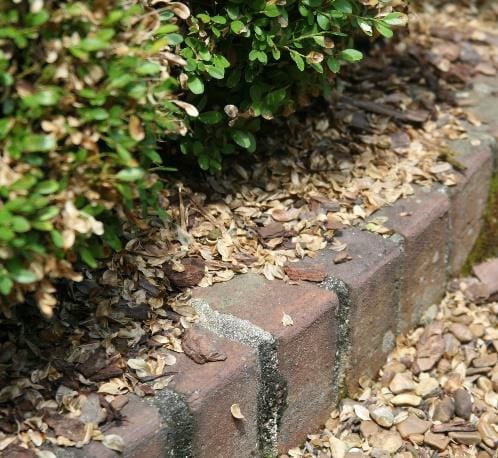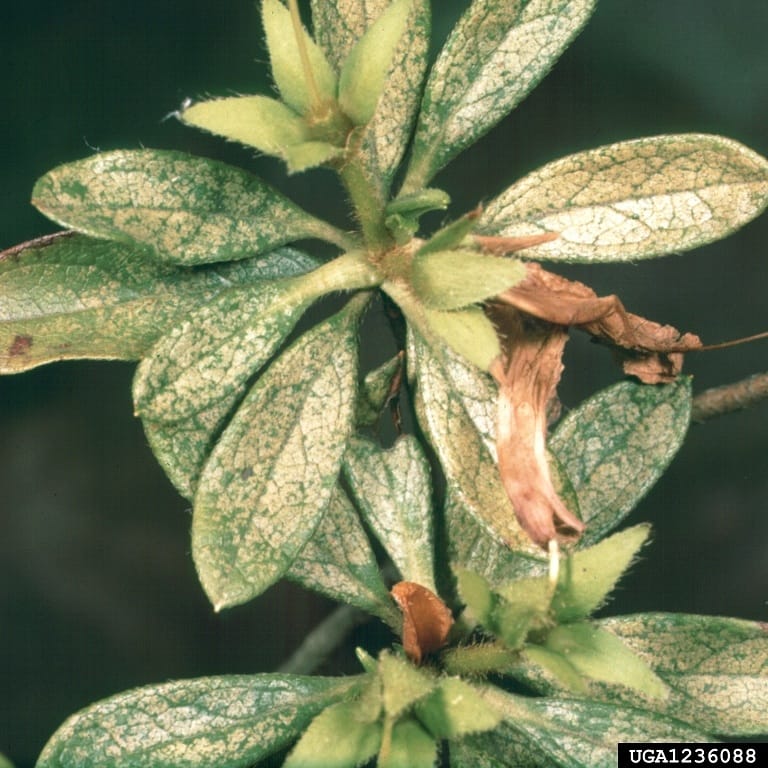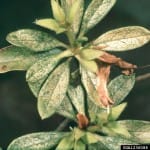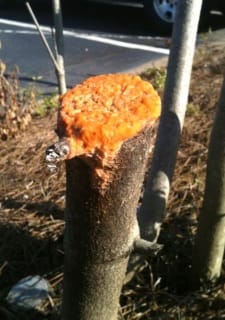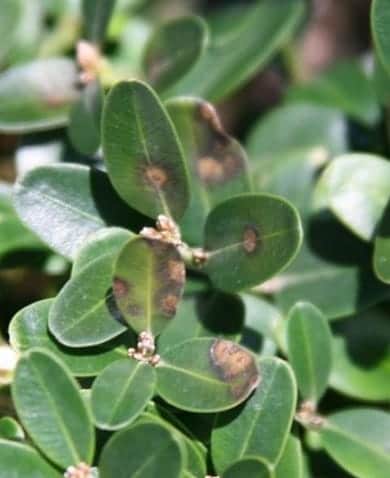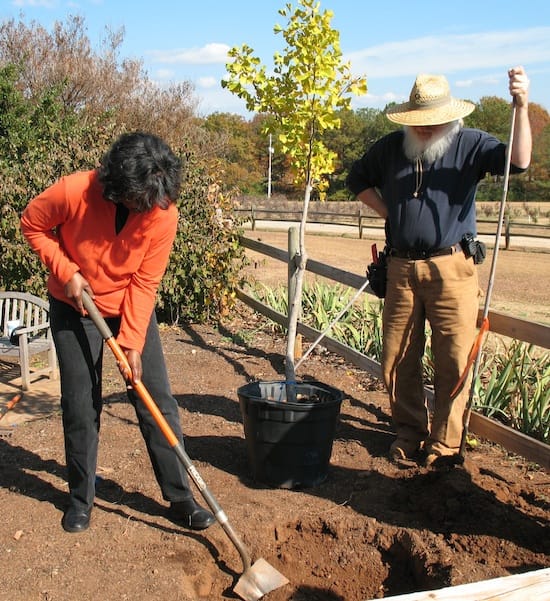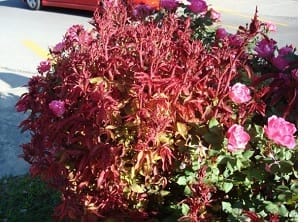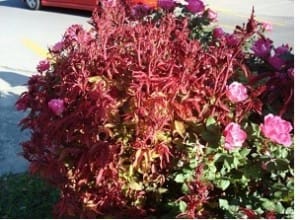Edited from an article by Jean L. Williams-Woodward, Extension Plant Pathologist. Read the entire article here.
Boxwood or Box Blight, caused by the fungus, Cylindrocladium pseudonaviculatum (syn. Cylindrocladium buxicola and Calonectria pseudonaviculata) has been confirmed in two residential landscapes in the Buckhead area of Atlanta.
The source of the introduction to one of the landscapes is unknown as new boxwood plants were not introduced into the landscape. The spores of the pathogen are very sticky and it is possible that the disease was introduced on worker’s tools or clothing. Plants within the second landscape were newly introduced from NC. Once introduced, the disease can be devastating to boxwood in landscapes and nurseries.
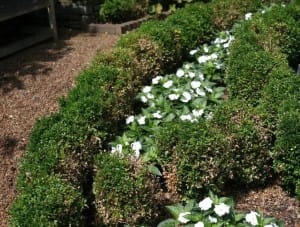
Hosts: Dwarf English boxwood (Buxus sempervirens ‘Suffruticosa’) is highly susceptible and develops severe symptoms and rapid leaf drop. American or common boxwood (B. sempervirens) cultivars are also very susceptible. Cultivars of Littleleaf (Japanese) and Korean boxwood (B. microphylla and B. sinica, respectively) appear less susceptible because they don’t show severe symptoms and leaf drop, but they are still susceptible.
None of the commercial boxwood cultivars are immune to this disease. In fact, lesser susceptible (e.g. tolerant) cultivars may act as a ‘Trojan Horse’ introducing the disease into landscapes containing more susceptible cultivars.
The value of lesser susceptible cultivars is in the establishment of new boxwood hedges. If planting a new area, use a more tolerant cultivar to lessen your disease pressure in subsequent years. The disease also affects other plants within the Buxaceae family, including Pachysandra terminalis (ground spurge) and Sarcococca sp. (sweet box).
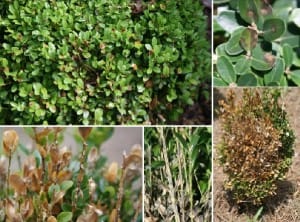
Management: The best control is exclusion. Do not introduce the disease on infected plants or tools. Inspect all new boxwood plants for symptoms of the disease. Be sure to check the lower leaf canopy and interior stems. Keep new plants isolated and separate from existing boxwoods. Do not apply fungicides to plants in isolation that would mask symptom development. Monitor plants for at least four weeks prior to introducing them into existing plantings.
If Boxwood blight is detected, the infected plants and all fallen leaf debris needs to be bagged on-site and removed from the area to be buried in a landfill to prevent its spread. Transport plants in closed bags. Leaf litter blowing from open trucks could spread the disease to plantings along the roadway. Fallen leaf debris should be vacuumed and bagged, burned on-site or buried. Debris should not be composted. The fungus also produces microsclerotia (small clump of fungal hyphae) within roots and leaf debris of infected plants that allows the fungus to survive for years. Removal of existing garden soil and replacing with new soil is an option, but there is no guarantee that this will completely remove the pathogen.
Boxwood blight cannot be controlled with curative fungicide applications. Fungicides are only effective when applied preventively. Fungicide efficacy trials have shown that fungicides containing chlorothalonil (Daconil, Spectro, Concert II) and fludioxonil (Medallion, Palladium) provided the best control when applied preventively. To a lesser extent, fungicides containing azoxystrobin (Heritage), pyraclostrobin (Pageant), trifloxystrobin (Compass), and thiophanate methyl (Cleary 3336, OHP 6672) provided fair to good preventative control. Most are not labeled for use on either boxwood, Cylindrocladium or both; however, this is changing, so check labels. Remember, spraying plants after the disease is present will NOT control this disease.
Recommendations for Landscapers:
- Inspect boxwoods on all properties. Look for symptomatic plants. As weather patterns become conducive (wet, humid, warm), disease symptoms may become noticeable and spread rapidly.
- Submit suspect samples to the UGA Plant Disease Clinic in Athens through county extension offices for disease identification.
- Train employees and clients on how to identify boxwood blight. Educate them on how easily the disease spreads.
- Only purchase plants from nurseries that have a Boxwood Blight Compliance Agreement through their State Department of Agriculture. Many plants are brokered, so ask where plants were grown. Keep new plants in isolation and monitor for symptoms prior to installation.
- Never install or prune or work in boxwoods when plants are wet.
- Always visit non-infected landscape sites first. Move healthy to suspect diseased areas; never the other way around.
- Disinfect pruners and other tools frequently within and between different blocks of plants within the same landscape, and especially when moving to different landscapes.
- The best product is Lysol Concentrate Disinfectant (containing 5.5% O-benzyl-p-chlorophenol). Mix 2.5 Tbsp per gallon of water. This can be made and kept in spray bottles. Tools need to be wet for at least 10 seconds and allowed to dry to be effective.
- A 10% bleach solution (1:9 part Clorox or 1:14 part Clorox Concentrate) for at least a 10 second soak can also be used, but this will oxidize tools. Soak and then let dry.
- When leaving a site suspected or known to have boxwood blight, all tools, shoes, and clothing must be disinfected.
- Get in the habit of wearing clean disposable booties or washing off debris and dirt entirely from soles of shoes between landscapes.
- Changing and laundering clothes between sites would be ideal; however, it’s impractical. Wearing disposable paper pants is an option.
